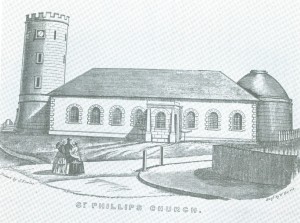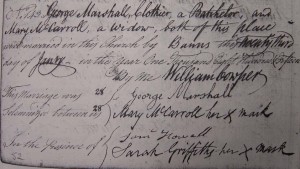PART THREE
MARRIAGE AND CHILDREN
We are unaware of the circumstances whereby George Marshall met Mary McCarroll, though many assigned convicts at the time lived in the Rocks area, working in other parts of Sydney In George’s case, Simeon Lord’s warehouse was just across the Tank Stream at what is now Macquarie Place. It would not have been difficult to meet at or near the Punch Bowl where Mary was assigned from the time of her arrival in 1814..
While still convicts, Mary and George were married in St Philip’s Church, Sydney on 23 January, 1815. This was only eight months after her arrival. Marriage was the most important choice open to women prisoners. Marriage could immediately transform the conditions of the women’s servitude through their assignment to their husbands where, although technically still prisoners, they could leave lives of free married women. [1] Their daughter’s birth only two months later suggests a close relationship within weeks of Mary’s disembarkation.
“This marriage was solemnised between us
George Marshall, Mary McCarroll her X mark; In the presence of Samuel Howell, Sarah Griffiths her X mark.”[2]
We are unaware of the connection with these witnesses.
- Sarah Whitehead aka Griffiths, age 28, was convicted in the Old Bailey in 1810, along with John Whitehead, of stealing two pair of breeches, value 30s. Sarah Griffiths (‘Nile’ 14 December 1810) , now in 1815 aged 44, was granted a Certificate of Freedom four years earlier in January 1810. It is likely she was the Sarah Griffiths who died in Sydney on 6 January 1816.[3]
- Samuel Howell arrived in the ill-fated Second Fleet , on the ‘Scarborough’ on 28 June 1790, after some 73 of the ship’s prisoners had died en route. He had been sentenced in Winchester, Hampshire to Life. He was pardoned by Governor Hunter. The 1814 Muster has him married to Ann Germaine (‘”Mary Ann”, 1791,and now Free) with two children. Ann was sentenced at Norwich in July 1790. The 1822 Muster has him employed with Simeon Lord and it is possible that it was there where he met George Marshall prior to becoming a witness to his marriage.
While there is much evidence that a great number of the convicts did not bother with church or civil marriages[4], George and Mary did so, at St Philip’s Church at the Rocks. It was built on what is, today, Lang Park. Old St Philip’s served Sydney from this date until 27th March 1856 when the present church was consecrated. William Cowper, who performed the marriage rites for George and Mary, was the Assistant Chaplain. He was to become the first (and only Rector) of ‘old’ St Philip’s. The 28 year old Cowper arrived in Sydney on 18th August 1809. He preached his first sermon in St Philip’s on 20th August, within 48 hours of his arrival. He was Rector of St Philip’s for 49 years. Among his distinguished children were Charles Cowper (later Sir Charles), five times Premier of New South Wales and the Very Reverend William Macquarie Cowper for 44 years the Dean of Sydney and the second Rector of St Philip’s.

St Phillip's later St Philip's Church, where the Marshalls were married and where the two children were christened.
The fact that Marshall and McCarroll were married in the Colony’s Anglican Church tells us little about their religion. One might make an assumption that the English and Irish origins suggest Anglican and Catholic respectively. There had been no Catholic priest or chapel since 1810 and this gap was to remain until the arrival of Fr J J Therry in 1820. Although Catholics probably made up more than half of the Rocks’ inhabitants, there was no Catholic church in the vicinity until St Patrick’s was built in the 1840s. Like their Protestant neighbours, many Catholics did use St Philips for baptisms and marriages.[5] But regular contributions Fr Therry’s planned new St Mary’s Catholic Church, well as the frequency of their names as witnesses to marriages in the newly opened St Mary’s Chapel from September 1823, and the attendance in the same year of their two children at the new ‘Higgins and Muldoon Roman Catholic School’, sponsored by Fr Therry, emphasise a Catholic leaning. Furthermore, Mary’s earlier connection in Dublin with the Jesuit Father Ryan, as well as her Irish daughter Margaret’s religion noted on her Indent as Catholic, confirms her religion.
In 1816 the Female Muster noted that Mary was the “wife of George Marshall”. It is most likely that she was no longer employed/assigned to Stafford Lett. It was common practice to assign convicts to their spouses, and this may have occurred immediately after Mary’s marriage in 1815. Despite the fact that George had only a Ticket of Leave at this time and was not legally ‘free’, one can reasonably be certain this took place. The necessary ‘Application to Marry’ might have provided some background, but this contemporary archive is unavailable.
Nor is there any indication where they were living at this time. They were later to move to the Brickfields area, on land to be known as Campbell Street. While there is a slight possibility that they did so in or around 1814, all we can be certain of was that they lived there “for many years before 1823” as certified by Commissioners for (Land) Claims in the 1830s. The wider issues and detail of his and others’ occupancy and title in Campbell Street are covered in a separate page.
There were two children of the marriage. Their daughter Mary Ann was born in Sydney on 24 March 1815. She was christened as Mary, in the same church where her parents were married, St Philip’s Church, on 23 April 1815. Her full name was ‘Mary Ann’. Their son, Charles was born in Sydney on 23 June 1817. He was christened, also in St Philip’s Church, on 27 July 1817.
The children’s schooling was provided by the Higgins and Muldoon School from 1822.
Mary Ann married Edward Conyngham in 1830 and her life with him is covered there. Charles did not marry until late in life and his life is covered separately.
The 1822 Muster noted that Mary McCarmel (sic) was George Marshall’s wife and ‘Free by Servitude”. This term described the practice whereby she gained her immediate practical freedom by marrying, her husband taking full responsibility for her.
From 1823 to 1827, George and Mary Marshall’s names appeared on no less than twenty occasions as witnesses to marriages at St. Mary’s RC Church Sydney.[6] Father J J Therry celebrated the marriages, the first being that of George Marshall’s employee Christopher Gilligan, previously mentioned. A full list is provided herewith, to enable future researchers to consider whether it may be possible to learn of their circle of friends. Some of the names are the same as some of the children at school in the early twenties with Mary and Charles. On the other hand, were the Marshall pair merely helping out the couples or the priest? There is evidence among the Therry papers that both took part in a number of church related activities, including fund raising.
| Date | Witness | Names |
| 6.9.1823 | George | Christopher Gilligan[7] and Esther Wade |
| 4.12.1823 | Both | John Kennedy and Mary Ryan |
| 16.8.1824 | George | Christopher Earl to Mary Kennedy |
| 6.11.1824 | Mary | Margaret Moore and John Knock |
| 19.11.1824 | George | Richard Selvey and Catherine Green |
| 31.1.1825 | Both | Florence(?) McCarthy and Susan Curran |
| 4.2.1825 | Both | John Daly and Hannah Lee. |
| 6.6.1825 | George | James Russell and Margaret Moore |
| 7.6.1825 | Mary | Thomas Donovan and Mary Regan |
| 2.10.1825 | George | Henry Seabrook and Elizabeth Galvin |
| 22.10.1825 | George | A West Esq of Parramatta and Sarah Keating |
| 6.11.1825 | Mary | William Rooburn and Margaret McCarroll[8] |
| 8.1.1826 | Mary | Alexander McGuigan and Sarah Flood |
| 9.4.1826 | Mary | Patrick O’Donnell and Margaret Laughlin |
| 22.9.1826 | Both | Thomas Cooper and Mary Gough |
| 24.6.1830 | Mary | Christopher Flinn[9] (sic) and Ellen Doogan |
| 19.8.1830 | Mary | Michael Connell and Sarah Maloney |
As to the McGuigan/Flood marriage above, Alexander McGuigan , born in the Colony, was a wheelright in George Street. Edward Conyngham.s brother Patrick Conyngham was assigned to him on arrival in the ‘Phoenix’ in December 1826. Patrick Conyngham wrote warmly of his employer in a newspaper exchange in mid 1827. This incident is covered here.
Edward Conyngham was not to arrive until 1829, nor to marry Marshall’s daughter until 1830, and there is no evidence that there was any Conyngham/Marshall connection.
For transfer to Part Four, click here.
- A Cargo of Women by Babette Smith↵
- St Philip’s Register item 143 in NSW State Records, COD390.↵
- Bigge Appendix Mitchell Library CY721.↵
- Grace Karskens. ‘The Rocks. Life in Early Sydney.’↵
- James Waldersee. ‘Catholic Society in NSW.’↵
- St Mary’s Marriages: Roll SAG 6 (FM4/5270) Mitchell Library.↵
- “DAPHNE” 1819. 7 yrs. Assigned to George Marshall at least until 1822 according to District Constable’s Notebooks. [SR Reel 1254]↵
- Mary’s Marshall’s daughter recently arrived on the ‘Mariner’ (2).↵
- Possibly Christopher Flynn, who at the time was publican of the (Mary Marshall owned) Bee Hive Inn.↵

